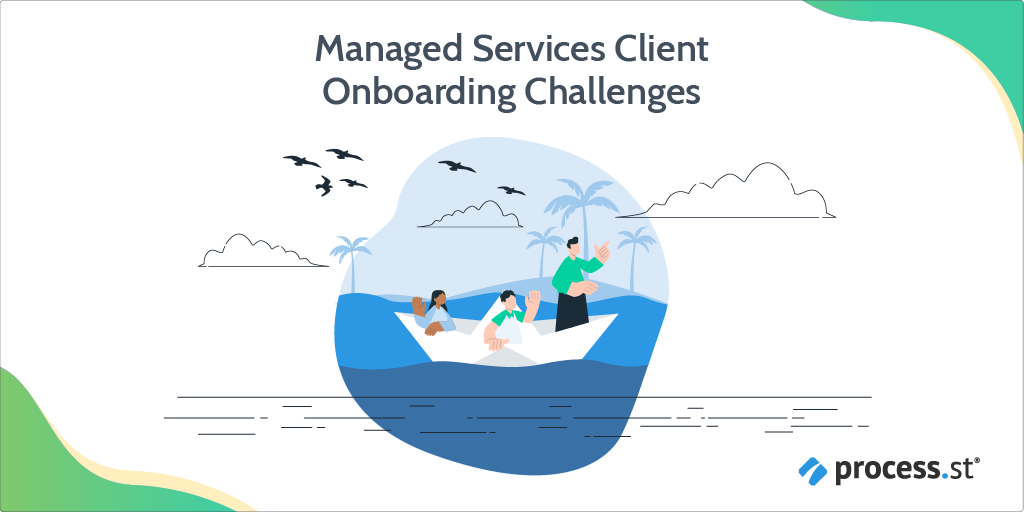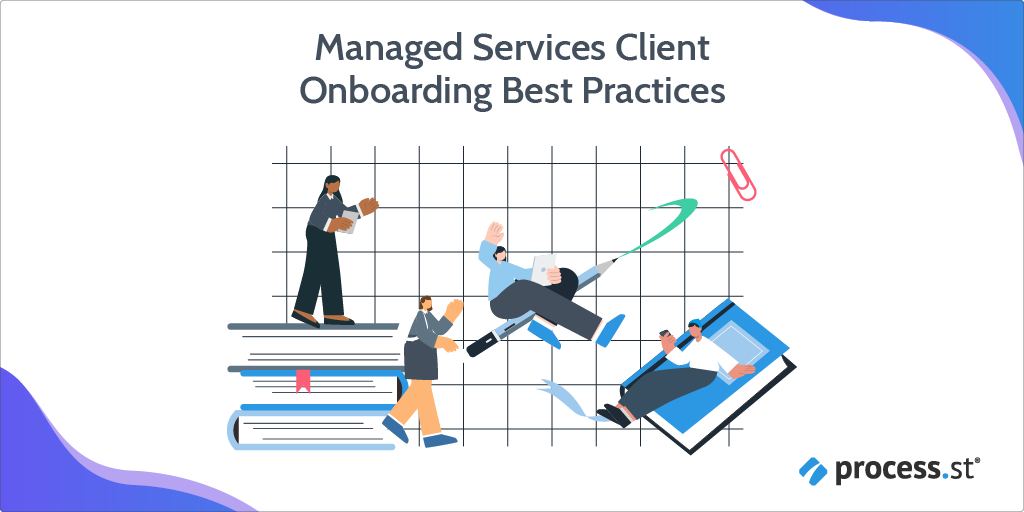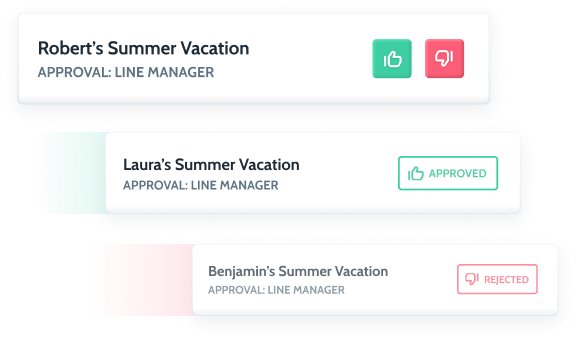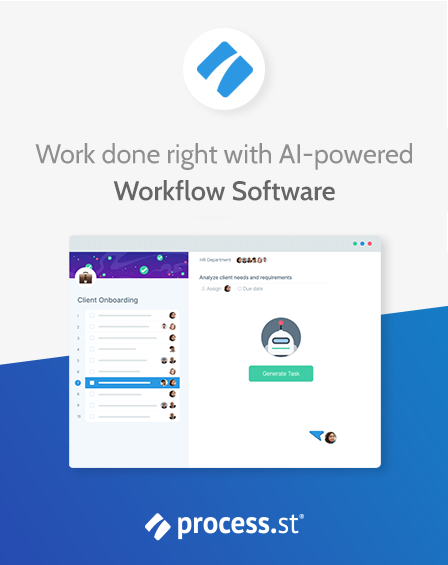Engage, retain, & satisfy customers with our easy-to-use no-code platform.
Everything You Need to Know About Managed Services Client Onboarding (+ Free Template)
We’re experts when it comes to managed services client onboarding. After all, we’re dealing with client onboarding on a daily basis.
But we also understand that getting your clients through this process is not easy.
Onboarding clients can be time-consuming and resource-heavy.
Designing the right onboarding plan is so challenging that businesses can struggle to create a great experience for their clients.
It doesn’t have to be that way.
And that’s why we want to share our knowledge and help streamline the process and reduce costs.
- What is a MSP Onboarding Process?
- The Importance of Managed Services Client Onboarding
- Challenges of Managed Services Client Onboarding
- Steps of a Managed Services Client Onboarding Checklist
- Best Practices for Managed Services Client Onboarding
- Free MSP Onboarding Process Template
- Managed Services Client Onboarding Automation (+ Free Template)
- Managed Services Client Onboarding Optimization
- The Future of Managed Services Client Onboarding
- Five Facts About Managed Services Client Onboarding
- FAQs about Managed Services Client Onboarding
What is a MSP Onboarding Process?
MSP (Managed Service Provider) onboarding is the process through which a new client is integrated into the service offerings of a managed service provider. It involves setting up and configuring systems, tools, and services according to the client’s needs and the MSP’s standards. The MSP onboarding process is designed to establish a strong foundation for the client-MSP relationship, ensuring that the client receives high-quality, reliable services from the start.
The Importance of Managed Services Client Onboarding
Managed services client onboarding is crucial for establishing a successful and long-lasting relationship between the MSP (Managed Service Provider) and the client. Proper onboarding sets the stage for a positive experience and lays the groundwork for effective ongoing service delivery.
Here are three reasons why client onboarding is important:
Smooth Transition and Reduced Disruption
Proper onboarding ensures a smooth transition from the client’s previous IT environment or provider to the MSP’s services. This minimizes disruptions to the client’s business operations and reduces the risk of downtime during the transition.
Clear Understanding and Alignment
Onboarding allows the MSP to gain a clear understanding of the client’s IT environment, needs, and goals. This alignment helps the MSP tailor services to the client’s specific requirements, ensuring that the services provided add value and support the client’s business objectives.
Foundation for Trust and Long-Term Partnership
A successful onboarding process establishes trust between the MSP and the client. By providing efficient and effective services from the outset, the MSP demonstrates its reliability and commitment to the client’s success. This fosters a positive, long-term partnership and can lead to client retention and potential referrals.
Challenges of Managed Services Client Onboarding

Promising More Than You Can Deliver
A common challenge in managed services client onboarding is overpromising to attract as many clients as possible. When the service or product fails to meet the client’s expectations, frustration can set in, often leading to the client leaving within 90 days. It’s crucial to avoid overpromising and set realistic expectations with clients to prevent dissatisfaction.
Lack of Responsive Customer Support
Clients often purchase a product or service and then struggle to find support when needed. When the customer service team is unresponsive, the client may feel neglected and decide to leave. Remember, clients may not be as familiar with your product as you are, so providing resources such as video tutorials and walkthroughs can help them understand and use your product effectively.
Difficult Onboarding Process
A challenging onboarding process can confuse clients and lead them to abandon the product. By utilizing a workflow management solution, you can streamline the onboarding process and assign tasks to the relevant team members, allowing the rest of the team to focus on other jobs. Integrating apps you’re already using, such as Google Docs or Zapier, can also enhance efficiency and improve the client experience.
Steps of a Managed Services Client Onboarding Checklist
Step 1: Initial Consultation
The initial consultation is the starting point of the onboarding process. During this phase, the MSP meets with the client to discuss their business needs, goals, and expectations. This consultation serves as an opportunity for the MSP to gather detailed information about the client’s current IT infrastructure and systems.
Understanding the client’s operational environment and objectives allows the MSP to identify potential challenges and opportunities for improvement, setting the stage for tailored service offerings.
Step 2: Assessment and Audit
In the assessment and audit phase, the MSP conducts a comprehensive review of the client’s existing IT environment. This involves evaluating hardware, software, network configurations, and security measures to identify potential vulnerabilities and areas for enhancement.
By thoroughly auditing the client’s systems, the MSP can gain insights into the client’s current setup and pinpoint opportunities for optimization, ensuring that future services are aligned with the client’s specific requirements.
Step 3: Proposal and Agreement
Once the assessment is complete, the MSP presents a tailored proposal to the client based on the findings. This proposal outlines the recommended services and solutions, as well as service-level agreements (SLAs) and pricing.
The MSP and the client discuss the scope of services in detail, ensuring that the proposal aligns with the client’s goals and budget. Upon reaching an agreement, a formal service contract is established to solidify the partnership and set expectations for ongoing collaboration.
Step 4: Planning and Preparation
In the planning and preparation phase, the MSP develops a detailed onboarding plan that includes timelines, milestones, and resource allocation. This plan serves as a roadmap for the transition and implementation process, outlining key steps and responsibilities.
The MSP also prepares the necessary documentation, such as contracts, service agreements, and project plans, ensuring that both parties have a clear understanding of the onboarding process and expectations.
Step 5: Transition and Implementation
During the transition and implementation phase, the MSP executes the onboarding plan by transitioning the client’s systems and data to the managed services environment.
This phase requires careful coordination to minimize disruption to the client’s business operations. The MSP works closely with the client to ensure a seamless transfer of services, taking measures to maintain data integrity and system functionality throughout the transition.
Step 6: Testing and Validation
Testing and validation are crucial to confirm that the client’s systems function correctly in the new managed services environment. The MSP conducts thorough testing to identify and resolve any issues or discrepancies that may arise during the transition.
This phase ensures that the client’s systems meet the required performance and security standards, providing a solid foundation for ongoing service delivery.
Step 7: Training and Support
The final step in the onboarding process involves providing training to the client’s staff on how to use the new systems and services effectively. This includes educating them on best practices and any changes to existing workflows.
The MSP also offers ongoing support and assistance to address any questions or concerns the client may have. By providing continuous support, the MSP ensures a smooth transition and helps build client satisfaction and trust.
Together, these detailed steps create a comprehensive onboarding process that establishes a strong partnership between the MSP and the client, paving the way for successful, long-term collaboration.
Best Practices for Managed Services Client Onboarding

Only Promise What You Can Deliver
Being transparent and realistic about your services and capabilities helps set clear expectations with clients from the beginning. This approach reduces the risk of disappointing clients and helps maintain your credibility.
Design a Comprehensive Yet Amazing Onboarding Experience
Craft a detailed, efficient onboarding process that guides clients through your services seamlessly. Tailor the experience to your clients’ unique needs and goals, ensuring that they understand your offerings and feel comfortable using them.
Provide Responsive Customer Service
Clients appreciate prompt and helpful responses when reaching out for support. Establish a realistic timeframe for your team to respond to client inquiries and make it a priority to consistently meet this timeline.
Utilize Workflow Management Systems and Checklists
Organize the onboarding process using workflow management systems and checklists to enhance efficiency and clarity. Automate repetitive tasks and assign them to the appropriate team members for a smoother client experience.
Check in with Your Customer Every Month
Regular communication with clients helps maintain a positive relationship and allows you to address concerns or feedback in a timely manner. This proactive approach can strengthen your connection with clients and increase their satisfaction.
Free MSP Onboarding Process Template
We’ve broken the MSP onboarding process down into 5 steps.
Even better, we built a workflow template around those steps that you can literally start using right now.
You can also take advantage of our free demo (no credit card required).
Step 1: Gather Data (Get Down to the Basics)
Getting to know your client should be a priority at this stage. You’ll want to find out all your client’s needs and expectations.
Naturally, this is the stage where you also collect client details and their IT infrastructure.
And due to the unique nature of each client, it’s a good idea to prepare a new service level agreement each time.
Here are some of the details you’ll need to get from your new client:
- Company overview
- The main person to contact
- What services do they require, and why
- Relevant documentation
- Account details
A good workflow management system is vital in keeping your data organized and accessible.
Process Street Pages, for example, allows you to create a centralized knowledge base where you can store and update all of your important procedures.
Step 2: Introduce the Product (and Welcome the Client)
Ideally, you’d be in a position to offer your new client an onboarding representative. But if that’s beyond the scope of your business, a simple welcome email or an in-app notification is also good enough.
Additionally, provide your customer with a quick onboarding roadmap. This may be as easy as sending a message, tutorial, or a personalized workflow.
This will give your new client a good grounding and prepare them for what’s next.
For smaller companies or startups, sending a welcome kit may also be something to consider. The welcome kit may include a copy of the agreed terms and conditions, team introductions, or a product guide.
Share FAQs, knowledge base, guides, walkthroughs, case studies, and anything that may help your client. You want to reinforce your brand at this point and make your client excited to be a part of your journey.
Step 3: Schedule a Kick-off Meeting
Introductions shouldn’t end with a welcome email.
As part of your managed services client onboarding, schedule a kick-off meeting. In this meeting, you’ll introduce your client to the team, talk a little more about the product, and answer any questions.
If done online, record the meeting and share the recording with the client for future reference.
An introductory meeting’s agenda could look something like this:
- Team introductions and points of contact
- Review the client’s requirements and goals
- Highlight your product’s best features (in line with the client’s interests)
- Reviews expectations and concerns
- Schedule a catch-up call
Step 4: Train your Client (and Provide Exceptional Service)
Even though you may have shared some tutorials already, training your client is vital.
If the client’s company is large, this may also involve training their team.
This additional step will establish a better relationship because your client will know you care. More importantly, it’ll allow them to get into the nitty-gritty of using your product. Explain all the details you know your client will love and benefit from.
Webinars are particularly useful because they allow your clients to ask specific questions.
Step 5: Review the Onboarding Process (and Improve It)
Just because the client onboarding ends doesn’t mean you should rest.
This last step is essential. It allows you to review and improve all your onboarding processes in the future.
By sending your freshly onboarded client a post-onboarding survey, you gain valuable insight into what worked and what didn’t.
Once you’ve gone over a few such surveys, you’ll have a pretty good idea of what needs to be improved.
Managed Services Client Onboarding Automation (+ Free Template)
Do you have limited time to approve your employees’ tasks?
This is where workflow management software can come in handy.
Process Street workflows automate your approval process, so there are no more bottlenecks. You’ll receive an instant notification when a task needs your approval – and you can approve or reject it whether you’re at your desk or not.
You can also integrate your workflows with other apps like Slack, so your notifications can pop up there.
And when it comes to approving on rejecting tasks, you’ll receive an instant notification to approve or reject. So your team can get on with their day. And so can your clients.

Managed Services Client Onboarding Optimization
Optimizing your onboarding process may be the most important thing to get right.
It’s critical not to overlook this step because it may lead to client losses and churn increases.
Instead, treat managed services client onboarding optimization as an opportunity to:
- Add value
- Make it simple
- Ensure systems setup is clear and transparent
- Complete all reporting
Take a look at our free template for an idea of how this can be achieved.
This pre-made workflow is one of hundreds in our library. It transforms the onboarding process from grueling to strategically organized.
By working with a workflow such as this, you’ll be able to gather all the data you need, ticking off tasks as you go.
Moreover, you can assign workflows to specific people, integrate with over 3,000 apps, and track the activity of your new onboarding clients.
The Future of Managed Services Client Onboarding
More and more industries are jumping on the workflow management system bandwagon.
It’s safe to say that it can save time, cost, and resources, but it’s also the future of managed services client onboarding.
MSP requires careful planning to make it work. Workflows and checklists make the whole process effortless, to say the least.
For IT companies in particular, whether they’re enterprises or startups, a workflow management system can prove to be a godsend.
With pre-made workflows (like the ones Process Street offers), it’s just a case of filling in the details and personalizing them to your liking.
Five Facts About Managed Services Client Onboarding
- ✅ The onboarding process for Managed Service Providers (MSPs) can take up to a week to complete. (Source: Team Research)
- ✅ MSPs spend an average of 40 to 80 hours manually entering information from existing systems and databases during client onboarding. (Source: Team Research)
- ✅ Each client’s onboarding process is unique, as every organization has its own set of challenges and needs. (Source: Team Research)
- ✅ It is important to gather basic information about the client, including their IT infrastructure, in order to understand their requirements and draft a proper SLA. (Source: Team Research)
- ✅ The onboarding process includes steps such as signing the SLA, introducing the client to your organization, introducing your IT team to the client, and commencing system provisioning. (Source: Team Research)
FAQs about Managed Services Client Onboarding
What is the client onboarding process for MSPs?
The client onboarding process for MSPs encompasses everything from the moment a client is hired to the point their services go live. It involves gathering basic information about the client, signing a service level agreement (SLA), introducing the client to your organization, introducing your team to the client, planning for the future, commencing provisioning, and setting up help desk software.
Why is the client onboarding process important for MSPs?
The client onboarding process is crucial for MSPs as it sets the tone for the future relationship with clients. A poor first impression during onboarding can increase the churn rate. By following a well-structured approach, MSPs can create a positive experience for clients and develop a long-lasting relationship.
How much time do MSPs spend on onboarding a client?
On average, MSPs spend about 40 to 80 hours manually entering information from existing systems and databases to onboard each client. The onboarding process can take up to a week due to its time-consuming nature.
What information should MSPs gather from clients during onboarding?
MSPs should gather basic information about the client’s IT infrastructure, including the company name, client’s point of contact, service tier, number of servers and workstations, server and workstation specifications, managed services required, existing documentation, account credentials, business-specific details, and third-party support details.
Should MSPs involve a lawyer when signing the service level agreement (SLA)?
Yes, it is recommended for MSPs to involve a lawyer when signing the SLA with a client. Involving a lawyer helps minimize potential liabilities and ensures that the contract is tailored to meet the specific requirements of each client.
How can MSPs introduce their organization to a new client during onboarding?
MSPs can send a welcome document to the new client, typically in PDF format. This document should contain a summary of the organization, including its vision and history, a detailed description of the provisioning process, information about service offerings, useful URLs, and customer testimonials to reassure the client.







